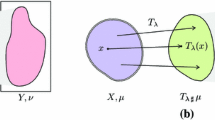Abstract
We present a novel convex shape prior functional with potential for application in variational image segmentation. Starting point is the Gromov-Wasserstein Distance which is successfully applied in shape recognition and classification tasks but involves solving a non-convex optimization problem and which is non-convex as a function of the involved shape representations. In two steps we derive a convex approximation which takes the form of a modified transport problem and inherits the ability to incorporate vast classes of geometric invariances beyond rigid isometries. We propose ways to counterbalance the loss of descriptiveness induced by the required approximations and to process additional (non-geometric) feature information. We demonstrate combination with a linear appearance term and show that the resulting functional can be minimized by standard linear programming methods and yields a bijective registration between a given template shape and the segmented foreground image region. Key aspects of the approach are illustrated by numerical experiments.







Similar content being viewed by others
References
Aherne, F., Thacker, N.A., Rockett, P.: Optimal pairwise geometric histograms. In: Proc. British Machine Vision Conf. (BMVC), pp. 480–490 (1997)
Belongie, S., Malik, J., Puzicha, J.: Shape matching and object recognition using shape contexts. IEEE Trans. Pattern Anal. Mach. Intell. 24, 509–522 (2002)
Bronstein, A., Bronstein, M., Kimmel, R., Mahmoudi, M., Sapiro, G.: A Gromov-Hausdorff framework with diffusion geometry for topologically-robust non-rigid shape matching. Int. J. Comput. Vis. 89, 266–286 (2010)
Burger, M., Franek, M., Schönlieb, C.-B.: Regularised regression and density estimation based on optimal transport. Appl. Math. Res. eXpress, March (2012)
Burkard, R.E., Çela, P.P., Pitsoulis, L.: The Quadratic Assignment Problem. Handbook of Combinatorial Optimization. Kluwer Academic, Dordrecht (1998)
Burkard, R., Karisch, S., Rendl, F.: QAPLIB—a quadratic assignment problem library. J. Glob. Optim. 10, 391–403 (1997)
Chan, T.F., Esedoglu, S., Nikolova, M.: Algorithms for finding global minimizers of image segmentation and denoising models. SIAM J. Appl. Math. 66(5), 1632–1648 (2006)
Charpiat, G., Faugeras, O., Keriven, R.: Shape statistics for image segmentation with prior. In: Computer Vision and Pattern Recognition (CVPR 2007), pp. 1–6 (2007)
Cremers, D., Kohlberger, T., Schnörr, C.: Shape statistics in kernel space for variational image segmentation. Pattern Recognit. 36(9), 1929–1943 (2003)
Cremers, D., Rousson, M., Deriche, R.: A review of statistical approaches to level set segmentation: integrating color, texture, motion and shape. Int. J. Comput. Vis. 72(2), 195–215 (2007)
Elad, A., Kimmel, R.: On bending invariant signatures for surfaces. IEEE Trans. Pattern Anal. Mach. Intell. 25(10), 1285–1295 (2003)
Gorelick, L., Galun, M., Sharon, E., Basri, R., Brandt, A.: Shape representation and classification using the Poisson equation. IEEE Trans. Pattern Anal. Mach. Intell. 28(12), 1991–2005 (2006)
Gromov, M.: Metric Structures for Riemannian and Non-Riemannian Spaces. Birkhäuser, Boston (2007)
Haker, S., Zhu, L., Tannenbaum, A., Angenent, S.: Optimal mass transport for registration and warping. Int. J. Comput. Vis. 60, 225–240 (2004)
Korte, B., Vygen, J.: Combinatorial Optimization, 4th edn. Springer, Berlin (2008)
Lellmann, J., Schnörr, C.: Continuous multiclass labeling approaches and algorithms. SIAM J. Imaging Sci. 4(4), 1049–1096 (2011)
McAuley, J.J., de Campos, T., Caetano, T.S.: Unified graph matching in Euclidean spaces. In: Computer Vision and Pattern Recognition (CVPR 2010), pp. 1871–1878 (2010)
Mémoli, F.: Gromov-Wasserstein distances and the metric approach to object matching. Found. Comput. Math. 11, 417–487 (2011)
Mémoli, F.: A spectral notion of the Gromov-Wasserstein distance and related methods. Appl. Comput. Harmon. Anal. 30(3), 363–401 (2011)
Mémoli, F., Sapiro, G.: A theoretical and computational framework for isometry invariant recognition of point cloud data. Found. Comput. Math. 5, 313–347 (2005)
Pock, T., Chambolle, A., Cremers, D., Bischof, H.: A convex relaxation approach for computing minimal partitions. In: Computer Vision and Pattern Recognition (CVPR 2009), pp. 810–817 (2009)
Rabin, J., Peyré, G., Cohen, L.: Geodesic shape retrieval via optimal mass transport. In: Computer Vision—ECCV 2010. LNCS, vol. 6315, pp. 771–784. Springer, Berlin (2010)
Reuter, M., Wolter, F.E., Peinecke, N.: Laplace-Beltrami spectra as “shape-dna” of surfaces and solids. Comput. Aided Des. 38(4), 342–366 (2006)
Schellewald, C., Roth, S., Schnörr, C.: Evaluation of a convex relaxation to a quadratic assignment matching approach for relational object views. Image Vis. Comput. 25, 1301–1314 (2007)
Schmitzer, B., Schnörr, C.: Convex coupling continuous cuts and shape priors. In: Bruckstein, A.M., ter Haar Romeny, B.M., Bronstein, A.M., Bronstein, M.M. (eds.) Scale Space and Variational Methods in Computer Vision (SSVM 2011). LNCS, vol. 6667, pp. 423–434. Springer, Berlin (2011)
Sethian, J.A.: A fast marching level set method for monotonically advancing fronts. In: Proc. Nat. Acad. Sci., pp. 1591–1595 (1995)
Sundaramoorthi, G., Mennucci, A., Soatto, S., Yezzi, A.: A new geometric metric in the space of curves, and applications to tracking deforming objects by prediction and filtering. SIAM J. Imaging Sci. 4(1), 109–145 (2011)
Van Loan, C.: The ubiquitous Kronecker product. J. Comput. Appl. Math. 123, 85–100 (2000)
Villani, C.: Optimal Transport: Old and New. Springer, Berlin (2009)
Acknowledgement
This work was supported by the German National Science Foundation (DFG) grant GRK 1653.
Author information
Authors and Affiliations
Corresponding author
Appendix
Appendix
Step 2 of the Proof of Proposition 4.5
We show by construction for any \(\rho\in\mathcal{M}(\phi_{X\,\sharp} \mu_{X}, \phi_{Y\,\sharp}\mu_{Y})\) the existence of some \(\mu\in\mathcal {M}(\mu_{X},\mu_{Y})\) such that ρ=ϕ ♯ μ. For any element (s X ,s Y )∈S X ×S Y construct the pre-image measure

where this element wise definition for each (x,y) is extended to all subsets of X×Y by
Now consider \(\mu= \sum_{(s_{X},s_{Y}) \in S_{X} \times S_{Y}} \mu_{(s_{X},s_{Y})}\): First verify that it is indeed contained in \(\mathcal {M}(\mu_{X},\mu_{Y})\):

since μ(x,y)≥0 for all (x,y). Furthermore

and likewise

for all measurable subsets σ⊆X×Y, σ X ⊆X, σ Y ⊆Y.
Now check whether ϕ ♯ μ=ρ:

Consequently any \(\rho\in\mathcal{M}(\phi_{X\,\sharp} \mu_{X}, \phi_{Y\,\sharp}\mu_{Y})\) is also contained in \(\phi_{\sharp}\mathcal{M}(\mu_{X},\mu_{Y})\) and the two sets are equal.
Rights and permissions
About this article
Cite this article
Schmitzer, B., Schnörr, C. Modelling Convex Shape Priors and Matching Based on the Gromov-Wasserstein Distance. J Math Imaging Vis 46, 143–159 (2013). https://doi.org/10.1007/s10851-012-0375-6
Published:
Issue Date:
DOI: https://doi.org/10.1007/s10851-012-0375-6




